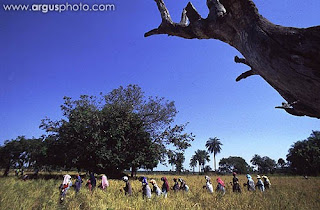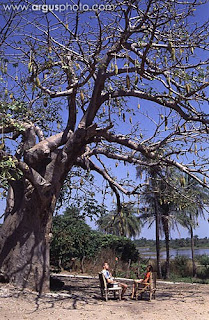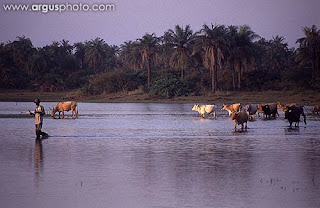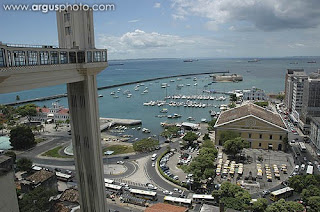In contrast
with the rest of the country, Casamance - French pronunciation; Portuguese: Casamança;
the area of Senegal south of the Gambia including the Casamance
River - offers a landscape of lush forests,
rice paddies, mangrove, and huge kapok trees. Its beaches are considered the
best in West Africa. The exceptional amount of sunshine, the warm sea, and the
group of wonderful hotels scattered along miles of fine sandy beaches make this
region a paradise for a relaxing vacation. A narrow
sliver of land sandwiched between Gambia and Guinea-Bissau, the Casamance is a
serpentine southern appendage to Senegal that shares few cultural affinities
with the rest of the country. Geographically, this moist and low-lying region
is dominated by the Casamance River, while its Atlantic coastline boasts some
of the most beautiful beach resorts in West Africa. Casamance is home to very traditional people who
jealously protect their identity. Some villages offer traditional
accommodations and activities for the tourists in an ecotourism program that
let the villagers use the income generated for development projects.
Divided in Basse Casamance (Baixa Casamança, Lower
Casamance, i.e. Ziguinchor Region) and Haute Casamance (Alta Casamança, Upper
Casamance, i.e. Kolda and Sédhiou Regions), its largest city is Ziguinchor, an
easy-going place where live around 230.000 inhabitants - the second largest
city of Senegal, after the capital Dakar -, with white houses and colonial Portuguese
and French architecture. Ziguinchor is an attractive town whose wide palm-lined
boulevards exude a likeably sleepy tropical ambience.
The compact town centre
is scattered with elegant buildings in varying states of disrepair. One of the
town’s more venerable buildings, the Cathédrale de Saint Antoine de Padoue is a
gleaming white apparition with candy-pink margins. On the waterfront, the most
poignant feature is a modest memorial to the victims of MV Le Joola, the
government ferry that capsized off the Gambian coast whilst travelling from
Ziguinchor to Dakar on 26 September
2002. The Marché Saint Maur des Fossés welcomes traders from all over Senegal,
as well as Guinea-Bissau and Mauritania. The adjacent Marché Artisanal supports
more than a hundred craftspeople, and items on sale include beautiful
sculptures. Another five minutes’ walk brings you to the Alliance
Franco-Sénégalaise, an impressive circular thatched building constructed in the
style of a traditional case à impluvium and
decorated in bright colors. The alliance often hosts exhibitions of local art,
there’s a pleasant bar-restaurant, and the main hall holds at least one evening
performance per week, be it live music, theatre or dance.
Ziguinchor is a perfect
base where to start exploring the region, taking a little pirogue at the mouth
of the Casamance River. A classical excursion from Ziguinchor is the one to the Îles aux
Oiseaux (‘Birds Islands’), a beautiful group of little islands where many
wild birds nest and live, around 10 km from the city. Along the way, boats
usually make a quick stop at small villages as Djilapao (with an interesting case à etage, a mud house of two floors, a rarity in the region)
and the much bigger Affiniam, where
it’s possible to enjoy a delicious meal and take a nap at the local campement, a typical guest-house
structure of Casamance. Try the thieb yape, a delicious plate of rice in tomato sauce, meat and sweet potato,
eventually followed by the strong local tea.
The region has ample rainfall, abundant in the south,
and the lower course of the Casamance River is covered by dense vegetation;
mangroves, oil palms, and raffia palms predominate. Rice, cotton, and corn are
cultivated. The Casamance River flows westward for the most part into the Atlantic Ocean along
a path about 200 miles (320 km) in length. However, only 80 miles (130 km) of
it are navigable. The Casamance is the principal river of the Kolda, Sédhiou, and Ziguinchor regions in the southern portion of Senegal between the Gambia and Guinea-Bissau.
The three regions are also collectively known as Casamance after the river. The next significant estuary to the south is the Farim River in
Guinea-Bissau, and to the north, the River Gambia,
namesake of the Gambia. The climate is low-lying
and hot, with some hills to the southeast. The Region has
average rainfall greater than the rest of Senegal,
exceeding 60 inches annually (1524mm) in some areas. The entire Casamance
region experiences a tropical savanna climate.
The Casamance was subject to
both French and Portuguese colonial efforts before a border was negotiated in
1888 between the French colony of Senegal and
Portuguese
Guinea (now Guinea-Bissau) to the south.
Portugal lost possession of Casamance, then the commercial hub of its colony. Casamance,
to this day, has preserved the local variant of Kriol known as Ziguinchor Creole,
and the members of the deep-rooted Creole community carry Portuguese surnames like Da Silva, Carvalho and Fonseca.
Interest in Portuguese colonial heritage has been revived in order to exert a
distinct identity, particularly in Baixa Casamança. Bissau-Guinean people are
also present in the region, as expatriates, immigrants, and refugees from the
poverty and instability that since long affects the neighboring country,
including a recent civil war.
The economy of the Casamance relies largely on rice cultivation and tourism.
It also has excellent beaches along its coastline, particularly at Cap Skirring, also
spelled Cap Skiring, a town on the Atlantic
Ocean coast of the Basse
Casamance. Cap Skirring is one of Senegal’s most famous resorts,
every bit as beautiful as the Petite Côte further north, but with a more unspoiled feel. Coming from the
fascinating but often climatically stifling interior, the fresh sea breezes
that caress this lovely stretch of coast are a delight, while those who fly in
from northern Senegal will be struck by the moister climate and lush
vegetation. This beautiful stretch of coast is punctuated with white sandy
beaches and rocky outcrops, while tracks lead from behind the shoreline to
palm-shaded fishing villages surrounded by rice fields. The focal point of tourism
here is the main drag through Cap Skirring, that was little affected by the
unrest that plagued the rest of the Casamance in recent decades and managed to
attract viable tourist volumes throughout the lean times. As a result, the
local tourist industry comes across as very stable and settled, and facilities
tend to surpass expectations. By contrast, the central market remains defiantly
African in mood, as does the chaotic gare routière (bus and taxi station). Cap Skirring is a popular seaside
resort frequented
mostly by European tourists. A gorgeous, wide beach, some
nightlife and several good restaurants (i.e.: La Maison Bleue, www.lamaisonbleue.org, specialized in seafood, Friday
or Saturday night seafood buffet; or the very good Italian restaurant La Terrazza). A perfect place for
holiday-makers, with an airport and a golf course.
The town was first occupied by fishermen, who still live in a part of the town,
easy to spot due to the big, colorful pirogues. It was ‘discovered’ by the
French of Ziguinchor as a balneal zone in the 1960s. A landing strip for small
planes was built at the end of 1960 by members of the Aero Club de Ziguinchor.
Much of the area that is now
Casamance was once the kingdom of Kasa. Kasa’s king, or mansa, was a leading trader with
the Portuguese, and Casamance takes its name from the Portuguese adaptation of Kasa mansa (king of Kasa). The region was subsequently
inhabited by migrants from the Mali empire, the Diola (Jola), the Fulani (Fulbe), the Malinke, and other groups. Casamance
was the last part of what is now Senegal to be conquered (beginning in 1903) by
Europeans, and small pockets of resistance were active until after World War I.
Isolated from the larger northern portion of the country, Casamance retained a
distinct identity; many of its inhabitants, for example, retained traditional
beliefs while the northern Senegalese adopted Islam. Its Diola inhabitants are known for their relaxed and friendly demeanor,
a reputation that was undermined during the 1982-2004 civil war, when much of
the region was unsafe for travel. Tourism has undergone a significant recovery
since the signing of the 2004 Peace Accord, and the people of the Casamance
remain as welcoming as ever, but driving after dark remains inadvisable, and
cautious travelers should seek current safety advice before visiting.
The French
liken the swampy Casamance to the Camargue, whose lagoons and marshes harbor spectacular
bird and animal life. Certainly, the flat areas of wide waters reflecting the
sky-blue heavens are reminiscent of that part of France. The further upriver
one travels, however, the more arid and harsh conditions become. Rain seldom
falls between mid-November and early May, and the Casamance can look very bleak
and arid towards the end of this long annual drought. When the clouds break in
late May or June, the ensuing storms are thrillingly violent. Floodplains that
looked terminally lifeless a month before sprout fresh greenery, and the
villages that cling to the life-giving margins of the Casamance take the
opportunity to plant rice, millet, sorghum, maize and other crops. The first
harvests, usually in September, are cause for great celebration, and colorful
festivals - involving bright costumes, some agile dancing and traditional Diola
wrestling competitions - are still held in a large number of rural areas.
Between harvests, most villagers depend on the river for sustenance. Living in
tune with the river, the people of the Casamance are great boatmen, and their
pride in river skills shows in the elaborate designs of their pirogues.
A
little ‘pearl’ of Casamance is Carabane,
a tiny island that can be reached by pirogue from Elinkine’s wharf. The small
village, surrounded by beaches, has some little hotel and restaurant, and a lot
of local atmosphere. Don’t miss. in the heart of the village, a visit to the Breton
Church of the XIX century.
And, to end at the best our trip through Casamance,
the last stop should be at the beautiful beach and town of Kafountine,
the perfect place where to relax for few days before taking the airplane back
home. The long beach has several resorts, cozy and affordable, that also offer
great food, surrounded by baobabs and other stunning plants. Daytime a little
walk to the village is a ‘must’, for a jump into pure Africa. Tropical fruits,
vegetable and colorful clothes points the market. In the outskirts of the town
there are many rice fields, where - if it’s the right moment and we’re lucky -
we can see the local women at work and, eventually, spot a gorgeous chameleon.
Local people drink the bunuk, a
strong alcoholic drink obtained by palm tree. It’s possible to see, here and
there, plastic bottles hanging from the trees, used by the villagers that have
an amazing skill of climbing along their very long trunks. Do not exaggerate,
but…enjoying a sip of bunuk, while
sitting at the beach during sunset, when cattle come back from the day in the
fields and the sun sets on the horizon line, is one of the best memories
Casamance and Senegal will leave with us. Enjoy it!
Published on CAAC Inflight Magazine (China)



































































